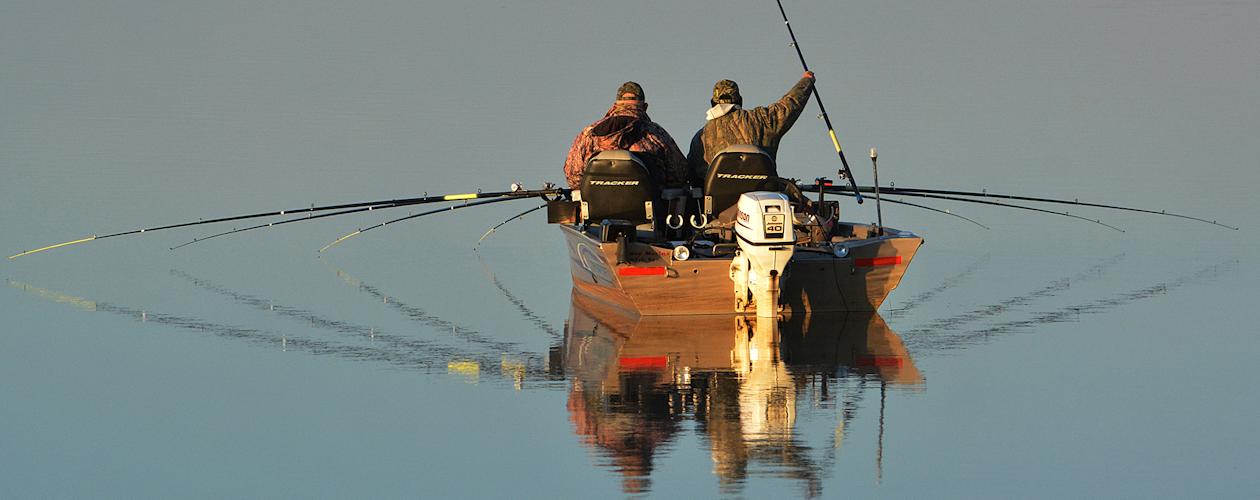Redear Bite Continues As Catfish Stay on Prowl
Written by Steve McCadams - Published on May 8, 2019
Still on the prowl this week are spawning catfish along the rocky banks of Kentucky Lake. Several nice ones have been taken in the backs of small coves and pockets just off the main lake too as the fish move up search for spawning territory plus feast on bluegill beds.
Also maintaining their position on the bragging board have been redear sunfish, commonly referred to as shellcracker. Some dandy stringers have been taken again this week by anglers tossing redworms, crickets and meal worms around shallow bushes.
Bluegill have been biting too but a lot of anglers have been somewhat mystified at the low numbers of big male bluegill plus their location. Some popular bedding locations have not paid dividends this spring and other spots are holding relatively low numbers. Finding a red hot
bedding zone has been somewhat challenging thus far.
No doubt the absence of aquatic vegetation has had a negative impact on the bluegill fishing these last two years. In the heyday of the grassbeds bluegill numbers and size seemed to increase dramatically.
That’s not to say some decent numbers haven’t been taken at times but the overall scenario seems to indicate bluegill have been quite scattered compared to times past. A few recent cool spells have also had an adverse impact as chilly nights lower the surface temperature and that will back off the aggressive fanning phases for a day or two.
Watch for the bluegill to rebound as warm days descend. Some days they even turn on in the afternoon after a slow start in the mornings once the sun warms things up. Both bluegill and redear are sensitive to cool snaps and north or northeast winds.
They thrive on stability of both weather and surface temperatures.
The panfish are also finicky in clear water conditions and quite light sensitive. It’s not hard to scare the fish in their shallow water hideouts if a boat pulls up and makes a lot of noise or muddies up the water, disturbing the comfort zone of these skittish bedding fish.
Meanwhile, most anglers are tossing light or ultralight spinning tackle armed with pegged bobbers or slip bobbers to regulate depth and detect light strikers. The slip bobbers aid anglers when casting.
Others opt to cast without a bobber, choosing to drag a bait slowly along the sandy gravel bottom that often entices strikes. At spawning time males will hit a bait not only from hunger but just to fight off intruders around the fanned out craters.
Veteran shellcracker fishermen are known to use a small bobber in the original cork color or a dull painted one as shallow water casting can spook finicky shellcracker.
When the fish occupy tight spots around trees and buck bushes some anglers opt to use long telescopic poles and gently fish over the tops of cover to reach bedding zones that are hidden from casting techniques.
Both the bluegill and redear bedding should last another couple of weeks. Bluegill generally go even longer as redear tend to scatter once their active spawning phases pass.
Redear are indeed a mystery fish. Each spring they blitz toward shallow shoreline structure or lay just offshore sometimes sharing spots with bluegill during the spawn. However, the whereabouts of the redear once late April and May passes is somewhat of a mystery to most anglers.
Known to feed on freshwater mussels---hence the name shellcracker---these powerfowl panfish do a disappearing act once they leave shallow water and spawning territory. Anglers have a short window of opportunity each spring so best hop to it while the bite is ongoing.
They’re a feisty fish that really pack a punch. Handsome too, as the males sport a dark olive drab color while females are somewhat pale green with a light yellow belly.
If you’re fortunate enough to find some aggressive bedding areas remember the daily creel limit is twenty. Don’t be too greedy and save some for the next guy!
From the crappie department comes a few mixed reports from some long liners and spider riggers who are still finding a few scattered and suspended fish. Depths of 7 to 12 feet have paid dividends but the number of boats seen crappie fishing have dwindled these last two weeks.
Trolling crankbaits is another technique that begins to produce once crappie enter their post-spawn phase and suspend out over open water areas. This style allows boaters to cover a lot of water in a slow methodical method while paying close attention to sonar screens showing the depth ranges of roaming fish.
A few boats have continued to stalk manmade fish attractors while vertical fishing jigs and live minnows but the areas and technique have not paid dividends. However, watch for fish to start relating more to structure by the end of the month as they recover from the stress of spawning and surface temps heat up.
Surface temperatures this week have stayed in the 74 to 76 degree range. Water color is clear across most of the reservoir, although rain and thunderstorms are entering the picture for the next few days.
Lake levels had been dancing around the summer pool elevation of 359 since last week but TVA is projecting a rise. The reservoir will jump about a foot and is projected to be in the 360.3 range by this weekend!
High water on the Mississippi River is likely having something to do with rising lake levels on Kentucky and Barkley lakes as discharge rates are reduced when that happens.
Bass fishing seemed to perk up a bit lately with decent stringers taken by anglers pitching and flipping shoreline buck bushes and trees with Texas rigged lizards and craws. Spinnerbaits and assorted topwater have worked too.
Tournaments held last weekend saw a few 20-pounds plus stringers weighed in by the top two or three teams.
Watch for the shallow bite to surge a bit with the rising lake levels this upcoming week. Higher lake levels will inundate shoreline habitat that was too shallow to fish last week. That means anglers will have a multitude of visible structure to fish in the secondary bays and pockets off the main lake.
Seems the variable lake levels continue for anglers who have managed to roll with it this spring. An unusual spring continues!
< Return to the Archives
< Return to Fishing Reports
< Return to Fishing Overview








